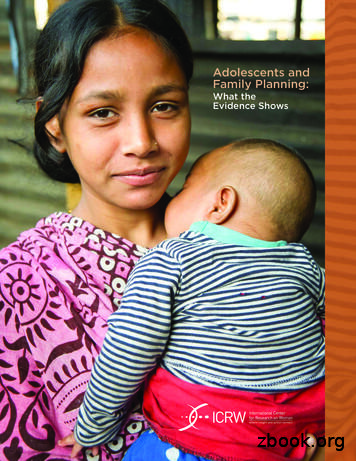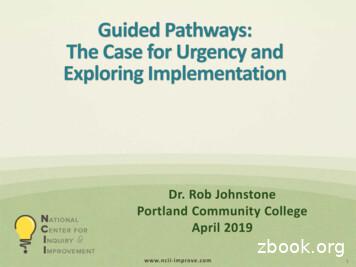Providing Quality Family Planning Services
Please note: An update has been published for this report. To view the update, please click here.Morbidity and Mortality Weekly ReportRecommendations and Reports / Vol. 63 / No. 4April 25, 2014Providing Quality Family Planning ServicesRecommendations of CDC and the U.S. Office of Population AffairsContinuing Education Examination available at http://www.cdc.gov/mmwr/cme/conted.html.U.S. Department of Health and Human ServicesCenters for Disease Control and Prevention
Recommendations and e Services.7Pregnancy Testing and Counseling. 13Clients Who Want to Become Pregnant. 14Basic Infertility Services. 15Preconception Health Services. 16Sexually Transmitted Disease Services. 18Related Preventive Health Services. 20Summary of Recommendations for Providing Family Planning andRelated Preventive Health Services. 21Conducting Quality Improvement. 21Conclusion. 25Appendix A. 30Appendix B. 35Appendix C. 45Appendix D. 47Appendix E. 48Appendix F. 51Disclosure of RelationshipCDC, our planners, content experts, and their spouses/partnerswish to disclose that they have no financial interests or otherrelationships with the manufacturers of commercial products,suppliers of commercial services, or commercial supporters.Planners have reviewed content to ensure there is no bias.The MMWR series of publications is published by the Center for Surveillance, Epidemiology, and Laboratory Services, Centers for Disease Control and Prevention (CDC),U.S. Department of Health and Human Services, Atlanta, GA 30329-4027.Suggested Citation: [Author names; first three, then et al., if more than six.] [Title]. MMWR 2014;63(No. RR-#):[inclusive page numbers].Centers for Disease Control and PreventionThomas R. Frieden, MD, MPH, DirectorHarold W. Jaffe, MD, MA, Associate Director for ScienceJoanne Cono, MD, ScM, Acting Director, Office of Science QualityChesley L. Richards, MD, MPH, Deputy Director for Public Health Scientific ServicesMichael F. Iademarco, MD, MPH, Director, Center for Surveillance, Epidemiology, and Laboratory ServicesMMWR Editorial and Production Staff (Serials)John S. Moran, MD, MPH, Acting Editor-in-ChiefChristine G. Casey, MD, EditorTeresa F. Rutledge, Managing EditorDavid C. Johnson, Lead Technical Writer-EditorJeffrey D. Sokolow, MA, Project EditorMartha F. Boyd, Lead Visual Information SpecialistMaureen A. Leahy, Julia C. Martinroe,Stephen R. Spriggs, Terraye M. StarrVisual Information SpecialistsQuang M. Doan, MBA, Phyllis H. KingInformation Technology SpecialistsMMWR Editorial BoardWilliam L. Roper, MD, MPH, Chapel Hill, NC, ChairmanMatthew L. Boulton, MD, MPH, Ann Arbor, MITimothy F. Jones, MD, Nashville, TNVirginia A. Caine, MD, Indianapolis, INRima F. Khabbaz, MD, Atlanta, GABarbara A. Ellis, PhD, MS, Atlanta, GADennis G. Maki, MD, Madison, WIJonathan E. Fielding, MD, MPH, MBA, Los Angeles, CAPatricia Quinlisk, MD, MPH, Des Moines, IADavid W. Fleming, MD, Seattle, WAPatrick L. Remington, MD, MPH, Madison, WIWilliam E. Halperin, MD, DrPH, MPH, Newark, NJWilliam Schaffner, MD, Nashville, TNKing K. Holmes, MD, PhD, Seattle, WA
Recommendations and ReportsProviding Quality Family Planning ServicesRecommendations of CDC and the U.S. Office of Population AffairsPrepared byLoretta Gavin, PhD,1 Susan Moskosky, MS,2 Marion Carter, PhD,1 Kathryn Curtis, PhD,1 Evelyn Glass, MSPH,2 Emily Godfrey,MD,1 Arik Marcell, MD,3 Nancy Mautone-Smith, MSW,2 Karen Pazol, PhD,1 Naomi Tepper, MD,1 Lauren Zapata, PhD11Division of Reproductive Health, National Center for Chronic Disease Prevention and Health Promotion, CDC2Office of Population Affairs, US Department of Health and Human Services, Rockville, Maryland3The Johns Hopkins University and the Male Training Center for Family Planning and Reproductive Health, Baltimore, MarylandSummaryThis report provides recommendations developed collaboratively by CDC and the Office of Population Affairs (OPA) of theU.S. Department of Health and Human Services (HHS). The recommendations outline how to provide quality family planningservices, which include contraceptive services, pregnancy testing and counseling, helping clients achieve pregnancy, basic infertilityservices, preconception health services, and sexually transmitted disease services. The primary audience for this report is all currentor potential providers of family planning services, including those working in service sites that are dedicated to family planningservice delivery as well as private and public providers of more comprehensive primary care.The United States continues to face substantial challenges to improving the reproductive health of the U.S. population. Nearlyone half of all pregnancies are unintended, with more than 700,000 adolescents aged 15–19 years becoming pregnant each yearand more than 300,000 giving birth. One of eight pregnancies in the United States results in preterm birth, and infant mortalityrates remain high compared with those of other developed countries.This report can assist primary care providers in offering family planning services that will help women, men, and couples achievetheir desired number and spacing of children and increase the likelihood that those children are born healthy. The report providesrecommendations for how to help prevent and achieve pregnancy, emphasizes offering a full range of contraceptive methods forpersons seeking to prevent pregnancy, highlights the special needs of adolescent clients, and encourages the use of the family planningvisit to provide selected preventive health services for women, in accordance with the recommendations for women issued by theInstitute of Medicine and adopted by HHS.IntroductionThe United States continues to face challenges to improvingthe reproductive health of the U.S. population. Nearly half (49%)of all pregnancies are unintended (1). Although adolescent birthrates declined by more than 61% during 1991–2012, the UnitedStates has one of the highest adolescent pregnancy rates in thedeveloped world, with 700,000 adolescents aged 15–19 yearsbecoming pregnant each year and 300,000 giving birth (2,3).Approximately one of eight pregnancies in the United Statesresults in a preterm birth, and infant mortality rates remain highcompared with other developed countries (3,4). Moreover, allof these outcomes affect racial and ethnic minority populationsdisproportionately (1–4).Corresponding preparers: Loretta Gavin, PhD, Division of ReproductiveHealth, National Center for Chronic Disease Prevention and HealthPromotion, CDC. Telephone: 770-488-6284; E-mail: lcg6@cdc.gov;Susan Moskosky, MS, Office of Population Affairs, US Department ofHealth and Human Services. Telephone: 240-453-2818; E-mail:susan.moskosky@hhs.gov.Family planning services can help address these and other publichealth challenges by providing education, counseling, and medicalservices (5). Family planning services include the following: providing contraception to help women and men planand space births, prevent unintended pregnancies, andreduce the number of abortions; offering pregnancy testing and counseling; helping clients who want to conceive; providing basic infertility services; providing preconception health services to improve infantand maternal outcomes and improve women’s and men’shealth; and providing sexually transmitted disease (STD) screeningand treatment services to prevent tubal infertility andimprove the health of women, men, and infants.This report provides recommendations developedcollaboratively by CDC and the Office of Population Affairs(OPA) of the U.S. Department of Health and Human Services(HHS). The recommendations outline how to provide familyplanning services by:MMWR / April 25, 2014 / Vol. 63 / No. 41
Recommendations and Reports defining a core set of family planning services for womenand men, describing how to provide contraceptive and other clinicalservices, serve adolescents, and perform qualityimprovements, and encouraging the use of the family planning visit to provideselected preventive health services for women, in accordancewith the recommendations for women issued by theInstitute of Medicine (IOM) and adopted by HHS (6).The collaboration between CDC and OPA drew on thestrengths of both agencies. CDC has a long-standing history ofdeveloping evidence-based recommendations for clinical care,and OPA’s Title X Family Planning Program (7) has served asthe national leader in direct family planning service deliverysince the Title X program was established in 1970.This report provides recommendations for providing care toclients of reproductive age who are in need of family planningservices. These recommendations are intended for all currentor potential providers of family planning services, includingthose funded by the Title X program.Current Context of FamilyPlanning ServicesWomen of reproductive age often report that their familyplanning provider is also their usual source of health care (8).As the U.S. health-care system evolves in response to increasedefforts to expand health insurance coverage, contain costs, andemphasize preventive care (9), providers of family planningservices will face new challenges and opportunities in caredelivery. For example, they will have increased opportunitiesto serve new clients and to serve as gateways for their clients toother essential health-care services. In addition, primary careand other providers who provide a range of health-care serviceswill be expected to integrate family planning services for allpersons of reproductive age, including those whose primaryreason for their health-care visit might not be family planning.Strengthened, multidirectional care coordination also will beneeded to improve health outcomes. For example, this typeof care coordination will be needed with clients referred tospecialist care after initial screening at a family planning visit,as well as with specialists referring clients with family planningneeds to family planning providers.Defining Quality in FamilyPlanning Service DeliveryThe central premise underpinning these recommendationsis that improving the quality of family planning services willlead to improved reproductive health outcomes (10–12). IOM2MMWR / April 25, 2014 / Vol. 63 / No. 4defines health-care quality as the extent to which health-careservices improve health outcomes in a manner that is consistentwith current professional knowledge (10,13). According toIOM, quality health care has the following attributes: Safety. These recommendations integrate other CDCrecommendations about which contraceptive methods canbe provided safely to women with various medicalconditions, and integrate CDC and U.S. PreventiveServices Task Force (USPSTF) recommendations on STD,preconception, and related preventive health services. Effectiveness. These recommendations support offeringa full range of Food and Drug Administration(FDA)–approved contraceptive methods as well ascounseling that highlights the effectiveness of contraceptivemethods overall and, in specific patient situations, drawsattention to the effectiveness of specific clinical preventivehealth services and identifies clinical preventive healthservices for which the potential harms outweigh thebenefits (i.e., USPSTF “D” recommendations). Client-centered approach. These recommendationsencourage taking a client-centered approach by1) highlighting that the client’s primary purpose forvisiting the service site must be respected, 2) noting theimportance of confidential services and suggesting waysto provide them, 3) encouraging the availability of a broadrange of contraceptive methods so that clients can makea selection based on their individual needs and preferences,and 4) reinforcing the need to deliver services in aculturally competent manner so as to meet the needs ofall clients, including adolescents, those with limitedEnglish proficiency, those with disabilities, and those whoare lesbian, gay, bisexual, transgender, or questioning theirsexual identity (LGBTQ). Organizational policies,governance structures, and individual attitudes andpractices all contribute to the cultural competence of ahealth-care entity and its staff. Cultural competency withina health-care setting refers to attitudes, practices, andpolicies that enable professionals to work effectively incross-cultural situations (14–16). Timeliness. These recommendations highlight theimportance of ensuring that services are provided to clientsin a timely manner. Efficiency. These recommendations identify a core set ofservices that providers can focus on delivering, as well asways to maximize the use of resources. Accessibility. These recommendations address how toremove barriers to contraceptive use, use the family planningvisit to provide access to a broader range of primary careand behavioral health services, use the primary care visit to
Recommendations and Reportsprovide access to contraceptive and other family planningservices, and strengthen links to other sources of care. Equity. These recommendations highlight the need forproviders of family planning services to deliver highquality care to all clients, including adolescents, LGBTQpersons, racial and ethnic minorities, clients with limitedEnglish proficiency, and persons living with disabilities. Value. These recommendations highlight services (i.e.,contraception and other clinical preventive services) thathave been shown to be very cost-effective (17–19).MethodsRecommendations Development ProcessThe recommendations were developed jointly under theauspices of CDC’s Division of Reproductive Health andOPA, in consultation with a wide range of experts and keystakeholders. More information about the processes used toconduct systematic reviews, the role of technical experts inreviewing the evidence, and the process of using the evidenceto develop recommendations is provided (Appendix A). Amultistage process was used to develop the recommendationsthat drew on established procedures for developing clinicalguidelines (20,21). First, an Expert Work Group* was formedcomprising family planning clinical providers, programadministrators, and representatives from relevant federalagencies and professional medical associations to help definethe scope of the recommendations. Next, literature aboutthree priority topics (i.e., counseling and education, servingadolescents, and quality improvement) was reviewed by usingthe USPSTF methodology for conducting systematic reviews(22). The results were presented to three technical panels†comprising subject matter experts (one panel for each prioritytopic) who considered the quality of the evidence and madesuggestions for what recommendations might be supported onthe basis of the evidence. In a separate process, existing clinicalrecommendations on women’s and men’s preventive serviceswere compiled from more than 35 federal and professionalmedical associations, and these results were presented to twotechnical panels of subject matter experts, one that addressedwomen’s clinical services and one that addressed men’s clinicalservices. The panels provided individual feedback aboutwhich clinical preventive services should be offered in a familyplanning setting and which clinical recommendations shouldreceive the highest consideration.* A list of the members of the Expert Work Group appears on page 52.† A list of the members of the technical panels appears on pages 52 and 53.CDC and OPA used the input from the subject matterexperts to develop a set of core recommendations and askedthe Expert Work Group to review them. The members ofthe Expert Work Group were more familiar with the familyplanning service delivery context than the members of theTechnical Panel and thus could better comment on thefeasibility and appropriateness of the recommendations,as well as the supporting evidence. The Expert WorkGroup considered the core recommendations by using thefollowing criteria: 1) the quality of the evidence; 2) thepositive and negative consequences of implementing therecommendations on health outcomes, costs or cost-savings,and implementation challenges; and 3) the relative importanceof these consequences, (e.g., the likelihood that implementationof the recommendation will have a substantial effect on healthoutcomes might be considered more than the logisticalchallenges of implementing it) (20). In certain cases, whenthe evidence from the literature reviews was inconclusive orincomplete, recommendations were made on the basis of expertopinion. Finally, CDC and OPA staff considered the individualfeedback from Expert Work Group members when finalizingthe core recommendations and writing the recommendationsdocument. A description of how the recommendations linkto the evidence is provided together with the rationale for theinclusion of each recommendation in this report (Appendix B).The evidence used to prepare these recommendationswill appear in background papers that will be publishedseparately. Resources that will help providers implement therecommendations will be provided through a web-based toolkit that will be available at http://www.hhs.gov/opa.Audience for the RecommendationsThe primary audience for this report is all providers orpotential providers of family planning services to clients ofreproductive age, including providers working in clinics thatare dedicated to family planning service delivery, as well asprivate and public providers of more comprehensive primarycare. Providers of dedicated family planning services might beless familiar with the specific recommendations for the deliveryof preconception services. Providers of more comprehensiveprimary care might be less familiar with the delivery ofcontraceptive services, pregnancy testing and counseling, andservices to help clients achieve pregnancy.This report can be used by medical directors to write clinicalprotocols that describe how care should be provided. Job aidsand other resources for use in service sites are being developedand will be made available when ready through OPA’s website(http://www.hhs.gov/opa).MMWR / April 25, 2014 / Vol. 63 / No. 43
Recommendations and ReportsIn this report, the term “provider” refers to any staff memberwho is involved in providing family planning services to aclient. This includes physicians, physician assistants, nursepractitioners, nurse-midwives, nursing staff, and healtheducators. The term “serv
cross-cultural situations (14 – 16). Timeliness. These recommendations highlight the importance of ensuring that services are provided to clients in a timely manner. Efficiency. These recommendations identify a core set of services that providers can focus on delivering, as well a
Catan Family 3 4 4 Checkers Family 2 2 2 Cherry Picking Family 2 6 3 Cinco Linko Family 2 4 4 . Lost Cities Family 2 2 2 Love Letter Family 2 4 4 Machi Koro Family 2 4 4 Magic Maze Family 1 8 4 4. . Top Gun Strategy Game Family 2 4 2 Tri-Ominos Family 2 6 3,4 Trivial Pursuit: Family Edition Family 2 36 4
2Family Planning National Board, Tunis, Tunisia. 3Family Planning and Reproductive Health Centre of Monastir, Monastir, Tunisia. Received: 24/10/05; accepted: 23/02/06 ABSTRACT We aimed to improve the quality of family planning and reproductive health services in a family planning centre though implementation of a quality improvement programme.
Family Planning Services in Madagascar: Assessing the Feasibility and Acceptability of Immunization Services as an Entry Point to Family Planning. Research Triangle Park, NC: Family Health International, Madagascar Ministry of Health and Family Planning, and Madagascar Institute of Public and Community Health, 2010.
family planning information and services. All of these studies used experimental or quasi-experimental methods. While not every study focused specifically on adolescents and family planning (i.e., some included family planning for adults or primarily addressed HIV prevention), all included some level of attention to adolescent family planning in-
Agenda on improving quality of family planning care.) The major question for this study was whether introducing a package of systems-based, provider-oriented, and client-centered interventions could make measurable improvements in targeted aspects of quality of care. Improving of Quality of Care for Family Planning Services in Uganda
Figure 3. Important Considerations for Family Planning in the PHC Service Delivery Components The government believes that integrating family planning with PHC will increase family planning coverage and improve overall population health. Malawi has made progress in creating and meeting demand for family planning, but it has a long way to
Story – Talk of the Block Family SV, “Kim and the Kids,” pg 9-10 Volunteer’s family pictures (if possible) Family worksheet (see below) Activity Ideas: Family tree: T introduces family by talking about own family and drawing a very simplified family tree on the board using the family vocabulary words (see above). Feel free to bring
Gateway Math & English Completion in 1. st. . FAMILY FEUD FAMILY FEUD FAMILY FEUD FAMILY FEUD FAMILY FEU FAMILY FEUD FAMILY FEUD FAMILY FEUD FAMILY FEUD FAMILY FE. National Center for Inquiry & Improvement www.ncii -improve.com Round 1: What Do New Students Ask .























